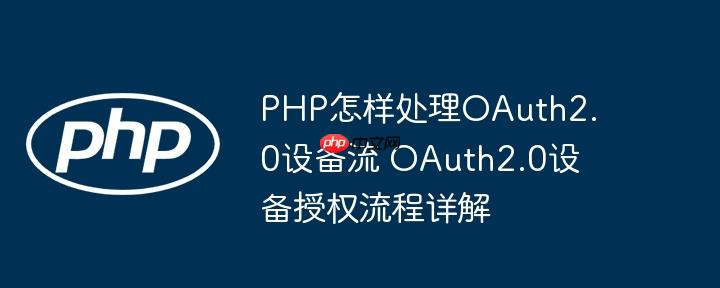php处理oauth 2.0设备流的核心在于实现受限设备通过用户在另一设备上输入代码完成授权的机制;2. 首先获取authorization server的设备授权端点url;3. 使用php的curl发送包含client_id和scope参数的post请求;4. 若响应包含device_code、user_code等信息,则显示user_code和verification_uri让用户完成授权;5. 使用device_code轮询token端点检查授权状态,设置合理的超时与间隔时间;6. 成功获取access_token后用于访问受保护资源;7. 超时问题通常由expires_in过短、interval过长、用户未及时操作或网络问题导致;8. client_secret用于验证客户端身份,是否需要取决于authorization server配置;9. 处理错误需检查http状态码及响应中的error字段,并根据不同错误代码采取相应措施。

PHP处理OAuth 2.0设备流,核心在于实现一个允许用户在没有浏览器或输入设备的受限设备上授权应用的机制。这通常涉及用户在另一设备(如电脑或手机)上访问一个URL并输入一个代码来完成授权。

解决方案

获取Authorization Server的设备授权端点信息: 首先,你需要知道Authorization Server的设备授权端点URL。这个信息通常在Authorization Server的文档里。
立即学习“PHP免费学习笔记(深入)”;

向设备授权端点发起请求: 使用PHP的curl或file_get_contents函数,向设备授权端点发送一个POST请求。请求体应该包含client_id和scope参数。
<?php
$clientId = 'your_client_id';
$scope = 'read write';
$deviceAuthorizationEndpoint = 'https://example.com/oauth/device/authorize';
$data = array(
'client_id' => $clientId,
'scope' => $scope
);
$ch = curl_init();
curl_setopt($ch, CURLOPT_URL, $deviceAuthorizationEndpoint);
curl_setopt($ch, CURLOPT_POST, 1);
curl_setopt($ch, CURLOPT_POSTFIELDS, http_build_query($data));
curl_setopt($ch, CURLOPT_RETURNTRANSFER, true);
curl_setopt($ch, CURLOPT_SSL_VERIFYPEER, false); // 生产环境必须验证证书
$response = curl_exec($ch);
curl_close($ch);
$result = json_decode($response, true);
if (isset($result['device_code'], $result['user_code'], $result['verification_uri'], $result['expires_in'], $result['interval'])) {
$deviceCode = $result['device_code'];
$userCode = $result['user_code'];
$verificationUri = $result['verification_uri'];
$expiresIn = $result['expires_in'];
$interval = $result['interval'];
echo "请访问: " . $verificationUri . "\n";
echo "并输入代码: " . $userCode . "\n";
// 接下来进行轮询,检查是否授权成功
} else {
// 处理错误
echo "Error: " . $response . "\n";
}
?>显示用户码和验证URI: 将user_code和verification_uri显示在受限设备上。用户需要访问verification_uri,并输入user_code来完成授权。
轮询Token端点: 使用PHP的sleep函数和curl,定期轮询Authorization Server的Token端点,检查用户是否完成了授权。
<?php
$tokenEndpoint = 'https://example.com/oauth/token';
$clientId = 'your_client_id';
$clientSecret = 'your_client_secret'; // 如果需要的话
$tokenData = array(
'grant_type' => 'urn:ietf:params:oauth:grant-type:device_code',
'device_code' => $deviceCode,
'client_id' => $clientId
);
// 如果需要client_secret
if ($clientSecret) {
$tokenData['client_secret'] = $clientSecret;
}
$ch = curl_init();
curl_setopt($ch, CURLOPT_URL, $tokenEndpoint);
curl_setopt($ch, CURLOPT_POST, 1);
curl_setopt($ch, CURLOPT_POSTFIELDS, http_build_query($tokenData));
curl_setopt($ch, CURLOPT_RETURNTRANSFER, true);
curl_setopt($ch, CURLOPT_SSL_VERIFYPEER, false); // 生产环境必须验证证书
$accessToken = null;
$error = null;
$startTime = time();
while (time() - $startTime < $expiresIn && !$accessToken && !$error) {
$tokenResponse = curl_exec($ch);
$tokenResult = json_decode($tokenResponse, true);
if (isset($tokenResult['access_token'])) {
$accessToken = $tokenResult['access_token'];
echo "Access Token: " . $accessToken . "\n";
break;
} elseif (isset($tokenResult['error'])) {
$error = $tokenResult['error'];
echo "Error: " . $error . "\n";
break;
} else {
// 等待一段时间后重试
sleep($interval);
}
}
curl_close($ch);
if (!$accessToken && !$error) {
echo "授权超时\n";
}
?>处理Token: 如果轮询成功,你会收到一个包含access_token的响应。使用这个access_token来访问受保护的资源。
OAuth 2.0设备流的安全性考量
设备流本身依赖于用户在另一个设备上的操作来完成授权,因此确保verification_uri是官方且可信的至关重要。同时,客户端(受限设备)需要妥善保管device_code,防止被恶意利用。此外,轮询Token端点时,需要设置合理的超时时间,避免无限期等待。
为什么我的OAuth2.0设备流总是超时?
超时问题通常有几个原因。一是expires_in设置过短,导致轮询时间不足。二是interval设置过长,轮询频率太低,错过了授权完成的时间窗口。三是用户没有及时在另一设备上完成授权。四是网络问题导致Token端点无法访问。检查这些因素,并适当调整expires_in和interval的值,同时确保用户能够顺利访问verification_uri。
设备流中client_secret的作用是什么,什么时候需要它?
client_secret用于验证客户端的身份。在某些OAuth 2.0实现中,特别是在客户端无法安全存储密钥的情况下,client_secret可能会被省略。然而,为了更高的安全性,建议尽可能使用client_secret。Authorization Server的配置决定了是否需要client_secret。如果Authorization Server要求,那么在请求Token时必须包含client_secret。
如何在PHP中优雅地处理OAuth 2.0错误?
PHP中处理OAuth 2.0错误,需要检查每次API请求的响应。成功的响应通常返回状态码200,并包含所需的数据。错误响应则可能包含不同的状态码(如400、401、403、500等)和一个包含错误代码和描述的JSON对象。
<?php
// 假设 $response 是 curl_exec() 的结果
$httpCode = curl_getinfo($ch, CURLINFO_HTTP_CODE);
$responseBody = json_decode($response, true);
if ($httpCode >= 200 && $httpCode < 300) {
// 请求成功
// 处理 $responseBody 中的数据
} else {
// 请求失败
if (isset($responseBody['error'], $responseBody['error_description'])) {
$errorCode = $responseBody['error'];
$errorDescription = $responseBody['error_description'];
echo "OAuth 2.0 Error: " . $errorCode . " - " . $errorDescription . "\n";
} else {
echo "HTTP Error: " . $httpCode . "\n";
}
// 采取适当的错误处理措施,例如记录日志、通知用户等
}
?>在实际应用中,你可能需要根据不同的错误代码采取不同的处理方式。例如,invalid_client表示客户端ID或密钥无效,invalid_grant表示授权码无效,unauthorized_client表示客户端未被授权使用指定的授权类型。详细的错误代码和描述应该参考OAuth 2.0规范和Authorization Server的文档。
以上就是PHP怎样处理OAuth2.0设备流 OAuth2.0设备授权流程详解的详细内容,更多请关注php中文网其它相关文章!

PHP怎么学习?PHP怎么入门?PHP在哪学?PHP怎么学才快?不用担心,这里为大家提供了PHP速学教程(入门到精通),有需要的小伙伴保存下载就能学习啦!




Copyright 2014-2025 https://www.php.cn/ All Rights Reserved | php.cn | 湘ICP备2023035733号